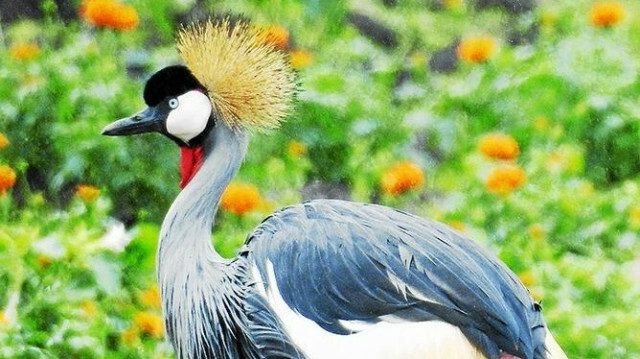
In 2012, the International Union for the Conservation of Nature (IUCN) put the Crested Crane on its list of endangered bird species.
Chosen as Uganda’s national symbol nearly 100 years ago, it is one of the most beautiful, majestic and cherished birds in the world. It walks with grace and serenity as though the life of the country it symbolizes depends on its every step. Its beauty and elegance were the reasons for its choosing to appear on Uganda’s national flag, emblem and coat of arms. When at rest, its multi-colored head represents the three colors of Uganda’s flag (black, yellow and red).
Scientifically known as Balearica regulorum gibbericeps, the bird inhabits Uganda’s swamps, freshly-ploughed fields and short to tall grass. It is an omnivore, meaning like humans, they eat a combination of both plants and animals. They feed by rapidly pecking at food but sometimes uproot plants and rarely dig.
Due to the rapid destruction of its habitat, the Crested Crane is becoming endangered. The combination of an increasing human population and improved agricultural techniques is leading people to drain swamps for cultivation, in direct contrast to the crane’s survival.
“The cranes’ nesting manner is unique, and they breed exclusively in wetlands, often laying between two and five eggs that are incubated by both sexes for anywhere between 28 and 31 days. Because they often return to the same spot year after year, any threat or destruction to such a habitat means the chances of breeding are reduced, said Paul Mafabi, director of environmental affairs at the Ministry of Water and Environment.”
He added that swamp cultivation unfortunately brings them in conflict with farmers for actual and perceived damage caused to crops.
There are about 8,000 Crested Cranes left in Uganda, down from 35,000 in 1989, according to the Ministry of Tourism, Wildlife and Antiquities.
“Despite its serenity, beauty and popularity, our national symbol is facing the threat of extinction if no measures of protection are decisively taken. Today, you are likely to see cranes perched atop road signs, pylons, rubbish dumps or airfields, indicating they are clearly running out of options for where to stay. The ban on massive reclamation of wetlands of 1986 did give some relief to cranes, but recent impunity in wetland reclamation could drive the species to extinction," Katongole Hadija, an environment lecturer at Kampala International University, told Anadolu Agency.
George Owoyesigire, the commissioner for wildlife conservation in the Ministry of Tourism, said that because of their exceptional beauty, many people are increasingly capturing the birds and domesticating them as pets.
“So the frequent hunting and capture of young ones or their eggs have also had drastic consequences for their numbers. It is also important to note that cranes do not breed in captivity,” he said.
He added that the monogamous nature of the cranes has also partly contributed to their low numbers.
“They are highly monogamous birds which pair once, for life. This means that if one of them is killed or domesticated, the likelihood of finding a new mating partner is almost non-existent.”
- Interventions
To reverse the declining numbers of the cranes, the Ministry of Tourism, Wildlife and Antiquates is applying the full force of the law to save the Crested Crane from extinction.
The Uganda Wildlife Act, 2019 stipulates a life sentence and a fine of more than $5 million for killing a Crested Crane as among the deterrents to offenders that target the birds.
Tom Butime, the Minister of Tourism, Wildlife and Antiquities, said the ministry will lead law enforcement towards the protection of wetlands for the good of wildlife and humans.
NatureUganda, which has been documenting and researching on the crane for the past 30 years, has also launched an initiative to conserve and restore key crane habitats including wetlands and water catchment areas to provide nesting places for the birds.













